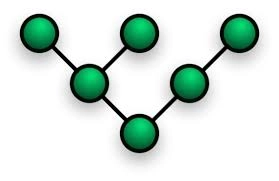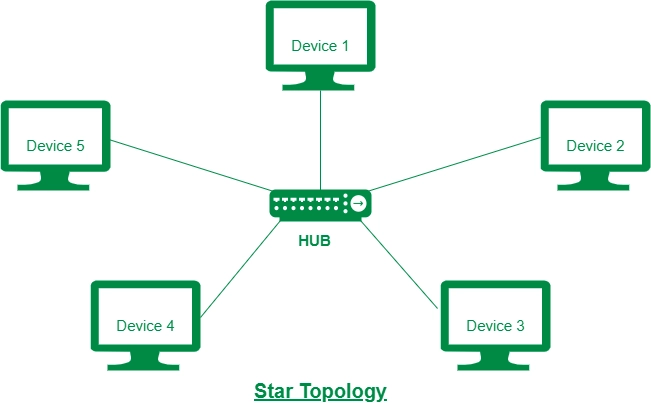Tree Topology in Computer Networks
Tree topology is a commonly used network topology in which nodes are arranged hierarchically like the branches and leaves of a tree. In this type of Network, there is a root node that is connected to one or more other nodes, which are referred to as child nodes. These child nodes may also have their own child nodes, creating a cascading structure that flows down like the branches and leaves of a tree.
What is Tree Topology
The single root node sits at the top of the hierarchy with branches expanding downward and outward as more nodes are added to the network.

The defining characteristics of a tree topology include:
- A root node that starts the tree. This is the only node that has no parent. All other nodes stem from this node.
- Leaf nodes that have no children. They are located at the tips of the branches of the tree structure.
- Middle nodes or branch nodes that both receive information from nodes above them and transmit data down the hierarchy.
- Nodes communicate directly only with other nodes that are immediately adjacent to them on the tree hierarchy.
- All data in the network flows either down from the root node or up from the leaf nodes. There are no direct horizontal connections between nodes on the same level.
Nodes in a tree network are often designed with point-to-point data links that resemble extended bus topologies. In other words, they leverage a shared communications channel through which data flows down to lower nodes and back up the tree.
How Tree Topology Works in Computer Networks
In a tree network, nodes that wish to communicate with each other first send data packets up the network structure until a common ancestor node is reached. This upper switch or router node then transfers the packet back down the hierarchy to the destination node.
For example, if leaf node 7 needed to send data to leaf node 10 in the diagram above, it would first route the data up through node D. Node D would then examine the destination address specified in the packet header and see that it matched the address for node 10. It would then send the packet back down through node E and finally to node 10.
The root node serves as the main distribution point in this topology. Data from an outside network enters the tree through the root and gets forwarded along branches until it reaches terminal nodes at the lower ends of the network. Likewise, any Communication originating from inside nodes on the tree gets funneled upward toward the root node before going out onto an external network.
Now, understanding this concept is simple and entertaining for Hasons. Using the Hason website you can always stay one step ahead in your job, business, or studies by purchasing New Age Desktops and All in One Desktops, i3 Intel Core Processor Desktop starting from 15000/-. Monitors, CPUs, and Gaming Desktop are also available. Register on Hasons and order your Tech Partner Now. Get exciting offers and benefits on your every purchase. Contact us so our support team can guide you in purchasing the right Tech Partner.
I5 8gb RAM 1tb HDD Gen 10400/Chipset Series H410 (Windows 10 Pro/1TB HDD/DDR4-8GB /Wired Keyboard, Mouse/ Black), Screen 21.5
SHOP NOW
Types of Tree Topology
There are a few different types of tree network topologies that can be implemented, depending on the use case:

Star Tree Topology
In a star tree configuration, all child nodes connect directly to the central root device. This offers excellent performance since data only has to make one hop to get to or from the root. However, it also limits the size of the network and introduces a single point of failure at the root.
Extended Star Tree Topology
An extended star topology adds another layer of child nodes underneath leaf nodes to extend the geographic reach or node capacity of the network. Data traverses up to three links between endpoint devices.
Hybrid Tree Topology
Hybrid tree networks contain nodes arranged in both star and bus topological layouts at different hierarchy levels. Some nodes may connect directly to the root in a star formation while others attach using a bus line that functions as a branch.
Importance of Tree Topology in Computer Networks
There are several key reasons why tree topologies play such an integral role in networking infrastructure:
Natural Mapping of Hierarchical Structures
Tree topologies provide a straightforward way to map the natural hierarchical relationships that exist in many organizations and IT Infrastructures. Networks can be designed to mimic corporate organizational charts, data center layouts, geographic company locations or other hierarchical domains.
Scalability
Adding and removing nodes from a tree topology is very simple, making these networks inherently scalable. As a network grows, new nodes can be seamlessly integrated by adding another layer of branches. Tree topologies can contain over a million nodes.
Efficient Convergence
Routing algorithms perform better on tree structures since there is only a single logical pathway between any two endpoints. This allows routing to converge more quickly. Spanning tree protocols are designed to create loop-free layer 2 topologies that resemble trees.
Support for Multicasting
The branching formation of trees maps nicely to IP multicasting communication. By sending packets from a root server, content can be efficiently distributed and replicated along branches to reach multiple receivers. Trees avoid bandwidth-intensive meshes.
Cost Effectiveness
Wired tree networks are relatively inexpensive to install and maintain compared to mesh topologies since each node only requires a single link to connect it back to a parent aggregator or distribution device. Upgrading capacity is also simple.
Advantages of Tree Topology
There are several notable advantages to using a tree network layout:
- Easy to extend – Adding new nodes is as simple as connecting them to an existing node and configuring a branch. No downtime required.
- Scalable – Trees can support very large networks with vast numbers of nodes. Allows for growth.
- Fault isolation – Localizes network faults. An issue is less likely to impact the entire network.
- Easy troubleshooting – Analyzing connectivity and pinpointing problems is straightforward due to hierarchical nature.
Disadvantages of Tree Topology
Some weaknesses of tree networks include:
- Single point of failure – The root node represents a disruption risk. If it fails, the entire network goes down.
- Limited redundancy – A break in any link isolates all downstream nodes with no backup path. Resiliency is restricted.
- Cumbersome changes – Adding capacity or new root nodes involves significant restructuring.
Conclusion
Tree topologies deliver an efficient way to structure communication in hierarchical one-to-many type Networks. Their branching shape mirrors how many organizations are departmentally structured while also providing optimized convergence and broadcast/multicast transmission.
| For updates in the Tree Topology in Computer Network read Hasons Blogs. Some of them are as follows: | |||
| Types of Computer Memory | Types of CPU Cooler | Application of GPS | Trading Monitor |
Tree Topology in Computer Networks
- What is tree topology in computer networks?Tree topology is a network layout built using nodes arranged hierarchically in a branching tree-like pattern. A root node sits at the base with middle nodes functioning as branches and leaf nodes terminating at the ends. Uni-directional data flow occurs either down from the root or up from endpoints.
- What is tree topology and advantage and disadvantage?The main advantages of tree topology are efficient broadcast/multicast transmission, straightforward scalability, and cost-effective cabling runs. Disadvantages stem from no redundant paths causing both limited fault tolerance and potential bottlenecks flow at the single root bridge point.
- Which cable is used in tree topology?Tree networks typically utilize twisted pair Ethernet cabling for any nodes connecting directly into the hierarchy. Fiber optic cabling may interconnect upper-layer backbone nodes like the root to provide increased bandwidth for traffic aggregation flows.
- What is leaf node in tree topology?A leaf node represents an endpoint device in a tree network located at the outer edges of the hierarchy. Leaf nodes have no downstream children and simply function as either data recipients or senders. Most communication from leaf nodes flows upward toward the root node.
- What is the other name of tree topology?Tree topology is sometimes referred to as a hierarchy topology due to its multi-layer parent-child arrangements. It may also be called a cascading topology in reference to distribution patterns steadily flowing down branches or a dendriform topology derived from the Greek word for tree.

